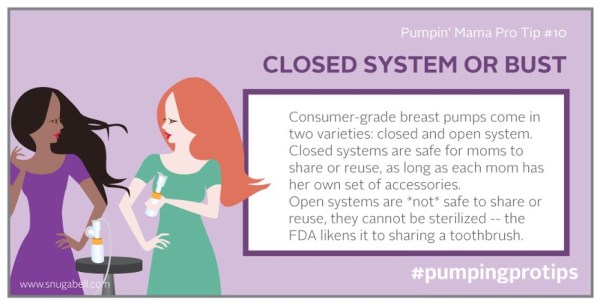by Wendy Bell, CLE
Editor’s note: A big thanks to Snugabell for their support of TLB and all breastfeeding women; please be sure to take a moment to thank Snugabell on their Facebook page for their show of support! You can also follow Snugabell on Twitter and Instagram: username @snugabell. Be sure to check out their special at the end of this article.
One thing we know about pumpin’ mamas is that they love to share. They share their experiences. They share their wisdom. Heck…sometimes they even share their milk.
Pumps themselves can be safely shared, provided they’re the right kind. Be sure to know the difference before giving or receiving a previously-loved pump!
The two types of pump are open system and closed system.
Open system allows the milk to come into contact with the internal workings of the pump. This makes the pump impossible to sterilize, and thus not an option when it comes to sharing. Closed systems, on the other hand, can be shared safely, provided that each mom has their own set of tubes, flanges, and collection bottles.
As an added benefit to closed system pumps, they will also prevent expressed milk from coming into contact with impurities drawn in from the surrounding air.
So feel free to accept or pass down that closed system pumps though it is important to note that not all closed system pumps are FDA approved for multiple users. It’s a great way to save money on one of the pricier items on the average registry and each mom can make it her own with a personal set of accessories (maybe including a PumpEase and stylish wet bag or two to keep it all together!) and though most insurance companies now days are required to cover a breast pump with each pregnancy, the loopholes and red tape can make that challenging. So for those that need a pump and can use a friend’s closed system or even for those that would benefit from having two pumps (full time work out of the home moms, like having double the parts, having double the pumps can really simplify things and reduce the chance of being stuck should one break or even of causing damage by regularly transporting it) can be a huge help.
To celebrate their SUPER exciting collaboration with Destination Maternity and A Pea in the Pod, Snugabell is sending PumpEase customers one of their fabulous Wet Bag absolutely FREE. Details here! The PumpEase design will securely hold your pump in place and is guaranteed to accommodate any breast pump on the market. The PumpEase bra like the one shown above makes multi-tasking a breeze for busy moms. Visit www.snugabell.com for more information about PumpEase.
















